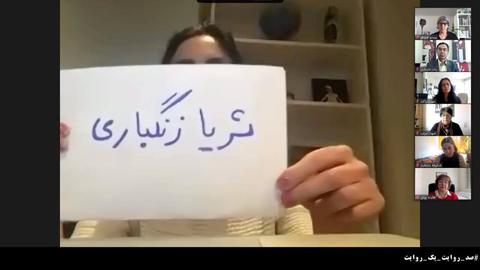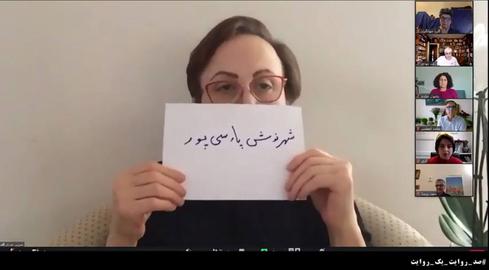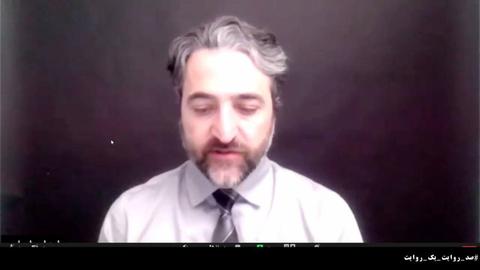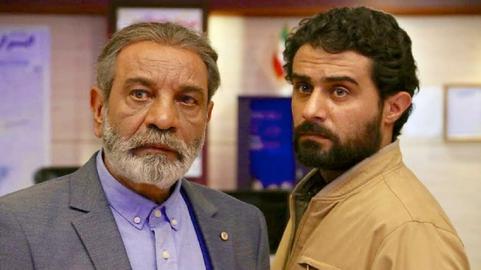On April 1, on the same day that supporters of the Islamic Republic celebrated the 42nd anniversary of the republic’s official establishment, a group of activists championing civil rights, women’s rights, human rights and political freedoms, from different backgrounds and different belief systems, joined together to keep the voices of the victims of the regime’s injustice alive, and to shed light on the plight of political prisoners of conscience in Iran and the inhumane conditions they endure in jail.
“100 Stories, the Same Storyline” presents the voices of former prisoners or members of their families on social media, telling the stories of people who have been targeted over the more than 40 years since the regime took power.
Among these testimonies were sketches drawn by prisoners of conscience and political prisoners over the last 42 years. Each of them tell stories of torture, of violations of prisoners’ rights, of hope for a more just future, and of despair that such a future might never arrive.
A former Baha’i prisoner talked about a fellow prisoner in the 1980s; another person who had been in jail in the 1980s told the story of a Kurdish prisoner; a former child prisoner told the world about jailed dervishes; another former Baha’i prisoner talked about imprisoned people from minority ethnic groups. And there were stories by or about people from the LGBT community and their experience of prison as well. In their call for justice, the project organizers presented a mosaic of the diversity of those jailed by the Islamic Republic. It offered a picture that many hailed as unprecedented.
The project was launched by Parastou Forouhar, an artist whose parents, Parvaneh and Dariush Forouhar, were assassinated in the late 1990s, one of many killings of dissidents that are jointly referred to as the “Chain Murders.” She presented a statement by a group of former prisoners regarding Behnam Mahjoubi, a Gonabadi dervish who died in Evin Prison on February 21 after eight months of torture and spending days in a coma.
Other stories were told by prominent figures, some of them former prisoners, including Mahnaz Parakand, Reza Alijani, Azam Jangravi, Mansoureh Behkish, Parvin Ardalan, Nargess Mohammadi, Sepehr Atefi, Kaveh Kermanshahi, Fatemeh Sepehri, Hamed Esmaeilion, Shiva Nazar Ahari, Roya Boroumand, Reza Khandan, Reza Moini, and Shirin Ebadi.
Each presented testimonies and memories of prisoners, among them the stories of Mahvash Shahriari, Ahmad Mousavi, Soraya Zangebari, Zeynab Jalalian, Monireh Baradaran, Masoud Abdollahi, Jahangir Esmailpour, Jila Baniyaghoob, Parvaneh Alizadeh, Fereshteh Ghazi, Mohammad Matin, Masoud Alizadeh and Shahrnush Parsipur. These one-time prisoners now told the stories of others who had been held behind bars.
These are the stories of truly diverse groups of people. Ethnic Arab, Kurdish and Baluchi prisoners, stories from prisons in Tehran, Mashhad and Kahrizak, male, female and transgender prisoners, Iranians and Afghans, prisoners from different political groups, from the People’s Mojahedin Organization, communists and Green Movement to student activists and women’s rights activists. They are the stories of imprisoned children, journalists and political activists, protesters who had taken to the streets over the last three years, prisoners from the 1980s to the 2010s — all of them put their own agendas or causes to one side and shared what they had in common: opposition to imprisonment, torture, solitary confinement and execution.
They told the stories of Fariba Sabet and other Baha’i prisoners and described the harassment they faced in prisons starting in the 1980s, and including the ban on them even speaking on common wards, meaning they essentially lived in solitary confinement.
In one tweet, Mansoureh Shojaei posted on behalf of Effat Mahbaz, who was in prison in the 1990s and whose husband was killed in the 1988 mass execution of political prisoners: “The whipping for evening prayer was done. It was time for the night prayer. I had to wait. The sound of lamentation, the sound of the Quran, the sound of the crows. Then it was my turn. Whipping came with every prayer. For days and weeks. This ‘prayer torture’ took the life of one of my cellmates: Soheyla Darvish Kohan, 22 years old. They killed her ... Or, to escape the suffering, she attempted suicide five times a day. But the result is the same. They murdered her. They executed her during prayer.”
They narrated the experience of Habibollah Davaran in the late 1980s, describing how, when the interrogator did not like his answers, he would shower him with profanities and lashed him even harder. Then there’s the story of the journalist Faraj Sarkohi, who had lost all hope: “I was condemned to death and I had no hope left. I was not officially a prisoner. My situation was different from all other prisoners, even those sentenced to death. They can be pardoned even if they have been sentenced to death. They can write letters. They can write their wills.”
Every year since it was founded, the Islamic Republic has been equated with imprisonment, torture and repression. Monireh Baradaran remembered what she went through while in solitary confinement in the 1980s. Taher Heydarian explained what it meant to be an ethnic Arab in the prisons of the Islamic Republic. Shiva was a transsexual who was arrested “at least once or twice a week” for what she was wearing or because of how she wore her hair. There is the story of Shirin Alam Hooli, a Kurdish prisoner who has not been granted any leave of absence, even for one day, and who cannot understand her interrogators when they question her in Persian. And Sepideh Gholian talked about the treatment of ethnic Arab prisoners.
Some of the other stories were about women’s Qarchak Prison in Varamin near Tehran, which prisoners referred to as the “World’s End”. They read accounts by Zhila Baniyaghoob and Keyvan Samimi, two journalists who were sent to prison for doing their job and telling the truth. And there were accounts of the torture of Zanyar and Loghman Moradi before they were hanged in 2018 in Sanandaj, the capital of Iranian Kurdistan.
Environmental activist Niloofar Bayani had stories of sexual harassment by her interrogators. Imprisoned dervishes talked about harassment, torture and death, a treatment which they believe shows “the dictator’s deep fear”.
Accounts by imprisoned children were another focus of the testimonies. A child named Esmail Khoshbooi was sent to prison with his mother and his three underage siblings when he was four. And Hamed Farmand, himself a child prisoner, gave a witness account of prisoners of conscience.
When the lawyer Mehrangiz Kar was in prison, the judge invited her to observe the trial of a woman charged with drug trafficking. The woman said the confessions she had made during interrogations were false.
Nima Parvaresh was on death row when he was interrogated to determine if he was a true Muslim or not. He retorted, demanding to know what kind of answer could possibly benefit Iran and its future.
Years have passed, and still 42 years on, the prisons have not closed, nor have the rights of the defendants started being respected. The Islamic Republic charged Habibollah Sarbazi, a Baluchi activist, with terrorism, tortured him and threw him into prison. Atena Daemi remembers how prisoners in solitary confinement would strike at the walls to boost the morale of other prisoners, showing them that they were not alone. Labor activist Esmail Bakhshi talks about the lasting damage that torture has inflicted on his body and his mind. The horrors of the 1980s and the brutalities of the 1990s have passed, only to be followed by the harsh treatment of prisoners that came with the aftermath of the disputed 2009 presidential election, and on to the nationwide protests in the past few years.
There is no shortage of victims of the Islamic Republic’s injustice over the past 42 years, no shortage of prisoners from various walks of life and political and social backgrounds, of mothers who joined their executed loved ones while waiting for a day when a just court would hold those responsible to account. There is no shortage of people who are still waiting for such an outcome, even after so many years.
In their statement, the organizers of the 100 Stories, the Same Storyline event state: “Executions, political murders, disappearances, physical and mental torture, mock executions, solitary confinement, forced exile of prisoners, forced repentance, forced confessions, harassment of family members...have been among the methods that this regime has used to consolidate its rule and to survive.”
Related Coverage:
Sepideh’s Diary: A Shocking Glimpse into Women’s Prisons in Iran
visit the accountability section
In this section of Iran Wire, you can contact the officials and launch your campaign for various problems




























comments